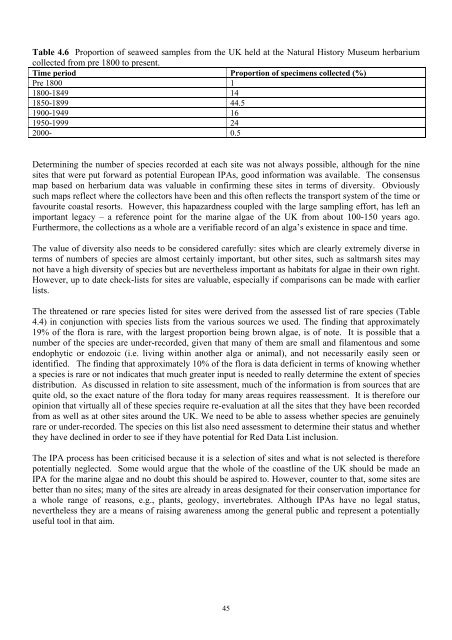Important Plant Areas for algae - Natural History Museum
Important Plant Areas for algae - Natural History Museum
Important Plant Areas for algae - Natural History Museum
Create successful ePaper yourself
Turn your PDF publications into a flip-book with our unique Google optimized e-Paper software.
Table 4.6 Proportion of seaweed samples from the UK held at the <strong>Natural</strong> <strong>History</strong> <strong>Museum</strong> herbarium<br />
collected from pre 1800 to present.<br />
Time period Proportion of specimens collected (%)<br />
Pre 1800 1<br />
1800-1849 14<br />
1850-1899 44.5<br />
1900-1949 16<br />
1950-1999 24<br />
2000- 0.5<br />
Determining the number of species recorded at each site was not always possible, although <strong>for</strong> the nine<br />
sites that were put <strong>for</strong>ward as potential European IPAs, good in<strong>for</strong>mation was available. The consensus<br />
map based on herbarium data was valuable in confirming these sites in terms of diversity. Obviously<br />
such maps reflect where the collectors have been and this often reflects the transport system of the time or<br />
favourite coastal resorts. However, this hapazardness coupled with the large sampling ef<strong>for</strong>t, has left an<br />
important legacy – a reference point <strong>for</strong> the marine <strong>algae</strong> of the UK from about 100-150 years ago.<br />
Furthermore, the collections as a whole are a verifiable record of an alga’s existence in space and time.<br />
The value of diversity also needs to be considered carefully: sites which are clearly extremely diverse in<br />
terms of numbers of species are almost certainly important, but other sites, such as saltmarsh sites may<br />
not have a high diversity of species but are nevertheless important as habitats <strong>for</strong> <strong>algae</strong> in their own right.<br />
However, up to date check-lists <strong>for</strong> sites are valuable, especially if comparisons can be made with earlier<br />
lists.<br />
The threatened or rare species listed <strong>for</strong> sites were derived from the assessed list of rare species (Table<br />
4.4) in conjunction with species lists from the various sources we used. The finding that approximately<br />
19% of the flora is rare, with the largest proportion being brown <strong>algae</strong>, is of note. It is possible that a<br />
number of the species are under-recorded, given that many of them are small and filamentous and some<br />
endophytic or endozoic (i.e. living within another alga or animal), and not necessarily easily seen or<br />
identified. The finding that approximately 10% of the flora is data deficient in terms of knowing whether<br />
a species is rare or not indicates that much greater input is needed to really determine the extent of species<br />
distribution. As discussed in relation to site assessment, much of the in<strong>for</strong>mation is from sources that are<br />
quite old, so the exact nature of the flora today <strong>for</strong> many areas requires reassessment. It is there<strong>for</strong>e our<br />
opinion that virtually all of these species require re-evaluation at all the sites that they have been recorded<br />
from as well as at other sites around the UK. We need to be able to assess whether species are genuinely<br />
rare or under-recorded. The species on this list also need assessment to determine their status and whether<br />
they have declined in order to see if they have potential <strong>for</strong> Red Data List inclusion.<br />
The IPA process has been criticised because it is a selection of sites and what is not selected is there<strong>for</strong>e<br />
potentially neglected. Some would argue that the whole of the coastline of the UK should be made an<br />
IPA <strong>for</strong> the marine <strong>algae</strong> and no doubt this should be aspired to. However, counter to that, some sites are<br />
better than no sites; many of the sites are already in areas designated <strong>for</strong> their conservation importance <strong>for</strong><br />
a whole range of reasons, e.g., plants, geology, invertebrates. Although IPAs have no legal status,<br />
nevertheless they are a means of raising awareness among the general public and represent a potentially<br />
useful tool in that aim.<br />
45

















